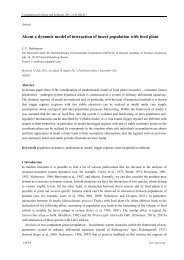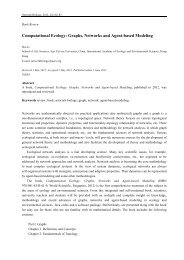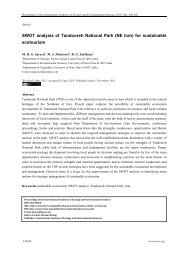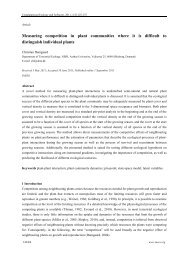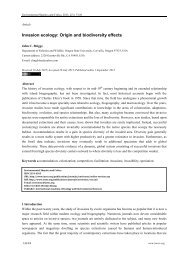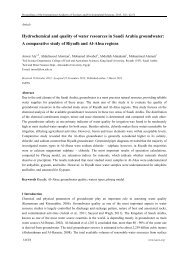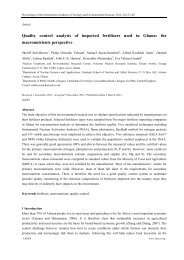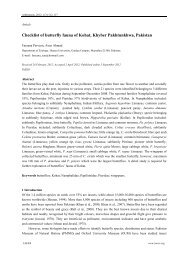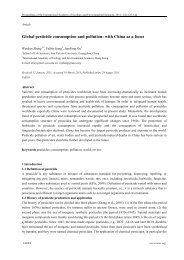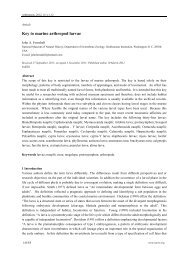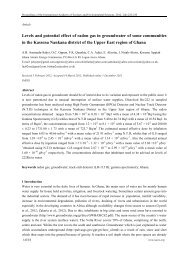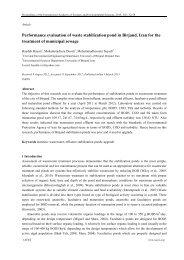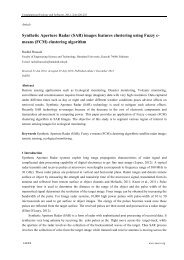Diversity and habitat preference of brachyuran crabs in Gulf of Kutch ...
Diversity and habitat preference of brachyuran crabs in Gulf of Kutch ...
Diversity and habitat preference of brachyuran crabs in Gulf of Kutch ...
You also want an ePaper? Increase the reach of your titles
YUMPU automatically turns print PDFs into web optimized ePapers that Google loves.
16<br />
Arthropods, 2012, 1(1):13-23<br />
sampl<strong>in</strong>g sites, respectively. Five species <strong>of</strong> <strong>crabs</strong> <strong>in</strong>clud<strong>in</strong>g Charybdis acutifrons, Charybdis feriatus,<br />
Ocypode ceratopthelma, Atergatis <strong>in</strong>tegerrimus, <strong>and</strong> Atergatis subdentatus were encountered only <strong>in</strong> one study<br />
site each. The maximum number <strong>of</strong> <strong>brachyuran</strong> crab species were recorded from Poshitra (11 species)<br />
followed by Mundra (9 species), Naliya (8 species) <strong>and</strong> Khambhaliya (8 species). Bhatia, Jodia <strong>and</strong> Sikka<br />
contributed same number <strong>of</strong> species (7 species) while m<strong>in</strong>imum species diversity was recorded from Jamnagar<br />
(4 species). In sampl<strong>in</strong>g sites diversity, maximum diversity <strong>of</strong> <strong>brachyuran</strong> <strong>crabs</strong> was recorded from site number<br />
2 while m<strong>in</strong>imum diversity was recorded from site number 7 (Table 2, Figs 3 <strong>and</strong> 4).<br />
As stated earlier, the whole study area is divided <strong>in</strong>to three different <strong>habitat</strong>s <strong>in</strong>clud<strong>in</strong>g mangrove mudflat,<br />
open mudflat <strong>and</strong> rocky shore, where the area <strong>of</strong> rocky shore was very small as compared to others so only two<br />
sampl<strong>in</strong>g sites were surveyed for rocky shore crab diversity. The <strong>habitat</strong> <strong>preference</strong> <strong>of</strong> <strong>brachyuran</strong> crab was<br />
studied <strong>in</strong> these three <strong>habitat</strong>s <strong>and</strong> maximum number <strong>of</strong> species was recorded from open mudflats followed by<br />
mangrove mudflats <strong>and</strong> rocky shore. Though the area <strong>of</strong> rocky shore was small still it supports comparatively<br />
good diversity.<br />
Total 10 species belong<strong>in</strong>g to 5 families <strong>and</strong> 8 genera were recorded from mangrove mudflat <strong>habitat</strong><br />
(Tables 2, 3). The number <strong>of</strong> species recorded for family Grapsidae which is typically found <strong>in</strong> mangrove<br />
environment was three. Family Portunidae contributed three species <strong>in</strong> the species account followed by<br />
Ocypodidae (2 species), Gecarc<strong>in</strong>idae (1 species) <strong>and</strong> Goneplacidae (1 species). Uca lactea annulipes <strong>and</strong><br />
Parasesarma plictum were recorded <strong>in</strong> seven different sites out <strong>of</strong> eight sites surveyed which makes them<br />
dom<strong>in</strong>ant species <strong>of</strong> the <strong>habitat</strong>. Other common <strong>brachyuran</strong> crab species <strong>of</strong> mangrove mudflat <strong>habitat</strong> recorded<br />
were Scylla serrata (5 sites) <strong>and</strong> Cardisoma carnifex (5 sites). Though family Grapsidae is very common <strong>in</strong><br />
mangrove <strong>habitat</strong> still except Parasesarma plictum other species like Grapsus <strong>in</strong>termedius <strong>and</strong> Grapsus<br />
albol<strong>in</strong>eatus were recorded from two <strong>and</strong> three different sites only, respectively. Neoepisesarma tetragonum<br />
belong<strong>in</strong>g to family grapsidae was not recorded from mangrove mudflat.<br />
0.96<br />
0.9<br />
6 7 2 3 1 4 5 8<br />
Similarity<br />
0.84<br />
0.78<br />
0.72<br />
066<br />
0.6<br />
0.54<br />
0.48<br />
0.42<br />
0 1 2 3 4 5 6 7 8 9<br />
Fig. 2 Dendrogram <strong>of</strong> <strong>brachyuran</strong> crab diversity recorded from different station <strong>of</strong> <strong>Gulf</strong> <strong>of</strong> <strong>Kutch</strong>.<br />
In open mudflat <strong>habitat</strong> total 11 species belong<strong>in</strong>g to 6 families <strong>and</strong> 10 genera were recorded (Tables 2, 3).<br />
Scylla serrata <strong>and</strong> Uca lactea annulipes were the dom<strong>in</strong>ant species as they were found <strong>in</strong> all the sampl<strong>in</strong>g sites<br />
<strong>of</strong> open mudflat <strong>habitat</strong> while the other common species like Macropthelmus pect<strong>in</strong>ipes, Grapsus <strong>in</strong>termedius,<br />
Parasesarma plictum, Neopisesarma tetragonum, Cardisoma carnifex were also recorded from the <strong>habitat</strong>.<br />
IAEES<br />
www.iaees.org



